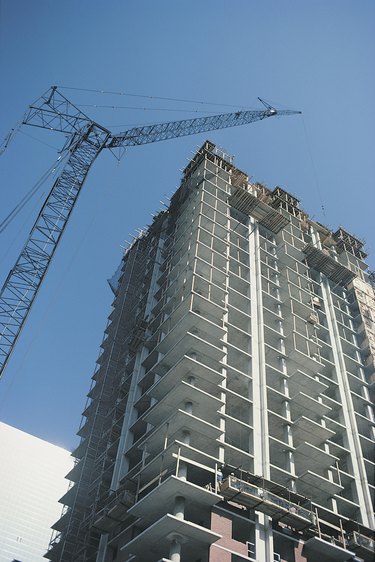Things You'll Need
Ground-penetrating radar equipment
Spray paint or plastic inserts
Concrete core drill
Chipping hammer
Disc cutter
Intermediate shoring
Support beams
Concrete
Tendon anchors

Structural engineers design concrete slabs with post-tension cables to obtain greater span lengths between supporting columns and to allow thinner slabs. Post-tension cables are steel wires inserted into plastic sheathing laid in place while pouring the concrete slab. Once the slab cures, qualified personnel apply tension and grout the cables. Contractors sometimes need to drill or cut into a post-tensioned slab for repair or renovation work. Cutting a tensioned cable, or tendon, can endanger the contractor and compromise the structural integrity of the slab. Building professionals frequently use ground-penetrating radar (GPR) to locate cables within concrete slabs and reinforce the slab during and after cutting operations.
Cutting Small Penetrations
Step 1
Locate existing post-tension tendons. Both post-tensioned tendons and reinforcement bar will show up on scans. The operator must determine which is which. Expand the survey area if unsure. Scanning a larger area provides more information to discern the layout of the slab structural elements. This helps discern which elements are PT tendons and which are reinforcement bars.
Video of the Day
Step 2
Obtain nondestructive testing equipment or hire qualified subcontractors to do nondestructive testing to help locate tendons and voids within the concrete slab. Ground-penetrating radar is a commonly accepted technology used to locate tendons.
Step 3
Identify post-tension tendons with GPR equipment. Look for mat support bars near the base of the slab. Support bars are uniformly spaced and at constant elevation. Tendons drape between supports columns in systematic patterns and groupings. If necessary, scan at multiple depth slices.
Step 4
Mark tendon locations on slab, using spray paint or stapling plastic inserts to the concrete forms. Determine if the penetration will be near a sleeve, block out, large conduit or other void.
Step 5
Strengthen the slab as directed by design engineer. Penetrate the concrete slab with a core drill or chipping hammer. Reconcrete the edges of slab at the perimeter of the opening.
Cutting Large Openings
Step 1
Determine the size of the opening. Large openings for stairwells or large duct shafts between floors often require cutting post-tensioned tendons. Determine potential locations for the new opening into the slab. These should avoid major structural members such as beams and bands of post-tension tendons.
Step 2
Analyze the structural impact that a large opening will have on the slab. Evaluate the predicted structural adequacy of the slab with the intended large opening. A qualified engineer can determine if the opening will compromise the slab's structural integrity, whether additional reinforcement is needed and, if so, which strengthening options to use.
Step 3
Follow the slab-strengthening plan, including any provisions that need to be implemented during the cutting operations. Identify planned intersection locations of post-tensioned tendons. Detension and reanchor those tendons at the perimeter of the intended opening. Remove concrete to make the opening, using a disc cutter to cut through tendons.
Step 4
Evaluate the structural capacity of the slab at the mid-point of the cutting operation. Follow a temporary shoring plan and install supports as needed.
Step 5
Reconcrete the edges of the slab at the perimeter of the opening. Cast new anchors to restress the remaining tendons.
Tip
Some common methods to strengthen the slab include adding new intermediate supports, increasing slab depth, adding concrete beams, creating a composite section by applying externally bonded steel or fiber-reinforced polymer, or adding external post-tensioning.
Warning
Consult a licensed professional engineer prior to conducting any operations that penetrate post-tensioned concrete slabs.
Engage the services of an experienced post-tensioning subcontractor to carry out operations.
Video of the Day
- Sensors & Software Post Tension Cable Characteristics: Sensors & Software
- PRS Ground Penetrating Radar Systems: Ground Penetrating Radar FAQ
- “Concrete Construction”; Cut It Out; Theodore Neff; April 2010
- Future Slab Penetrations and Demolition of Post-Tensioned Floors: Post Tensioning Institute of Australia
- Portland Cement Association: Post-Tensioned Concrete